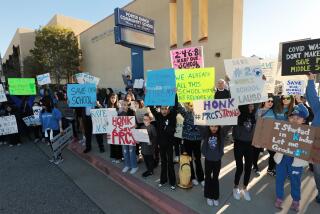Teachers’ strike is over, but LAUSD still faces threats from charters and finances

For all the cheers that came with the end of the teachers’ strike, it’s become clear that some of the Los Angeles Unified School District’s greatest woes could not be tackled at the bargaining table.
The nation’s second-largest school system remains beset by declining student enrollment, lagging academic achievement and serious financial problems — and privately operated charter schools still pose an existential challenge as they compete for students.
The union “won the public perception battle about the challenges that teachers face. And I think that’s a good thing,” said UCLA education professor Tyrone Howard. But that did not change the big picture financially or with charters, he said.
L.A. Unified, which has about 485,000 students, has been losing about 12,000 a year because of population trends and charter schools. Students translate to funding. The school system also faces a growing financial strain because of rising contributions to state-run pension funds and retiree health benefits.
The pension drain is hurting state school systems, said Elisha Smith Arrillaga, co-executive director of the nonprofit advocacy group Education Trust-West.
“All roads come back to the state” to better fund schools, she said.
To that end, the union’s success in focusing attention on public schools could help — if that momentum can be built on.
But for now, even though the union made gains it considers important, progress was limited in the near term on reducing the size of classes, which had been a central theme of the strike.
Class sizes will drop by one next year and one more the year after. If funds are available, they’ll drop further after that. The union also won a decrease in maximum possible class sizes in secondary English and math from 46 to 39.
In the final marathon negotiating sessions, the union never persuaded the district to throw in vastly more money. Instead, the district stuck to its financial analysis of potentially tough times ahead.
Union leaders defended the incremental progress as crucial, saying that class sizes are being driven downward and now are enforceable. They also point to the hiring of additional nurses, librarians and counselors.
“This is an unambiguous, unmitigated win,” said Alex Caputo-Pearl, the president of United Teachers Los Angeles.
With charter schools, it remains to be seen how meaningful the union’s successes will prove.
Privately operated charters, which are mostly nonunion, compete with traditional schools for students and the funding that follows them. Charters also have the legal right to share campuses with district-operated public schools.
The union won for teachers and traditional schools a greater voice in managing these sharing arrangements. But it did not end or limit them.
And though union leaders called for a moratorium on new charters, L.A. Unified is required by law to approve any valid charter petition that it receives for a new school within its boundaries.
The union did receive a commitment that the Board of Education would consider a resolution calling for the state to “cap” the number of charter schools. It’s not certain the resolution will pass. Three of the six current board members were elected with substantial support from charter school advocates.
Voting on the contract will continue through Friday, but union leaders called off the strike Tuesday night because membership approval seemed certain. The running tally shows more than 80% voting yes. A vocal minority complained that the deal achieves too little compared with the union’s rhetoric. Others are unhappy about the rushed voting process that resulted from efforts to get schools back to normal by Wednesday.
Some backlash has emerged from other quarters.
The California Charter Schools Assn. said it was unfair to target charters, which enroll 1 in 5 L.A. public-school students.
“Tens of thousands of parents in Los Angeles have made it clear that charter schools are the right fit for their children,” said association spokeswoman Caity Heim. “Most of these parents live in disadvantaged neighborhoods. ... Affluent parents should not be the only ones with options when it comes to their children’s education.”
Charters also have been affected by the declining number of students: Some have closed for lack of enrollment, and overall enrollment was flat last year. But charter funders believe there still is room for growth in parts of the district that are not yet saturated with charters. And they have given no indication that they intend to hold back.
The district serves mostly low-income Latino and black students, and most are faring worse academically than white and Asian students and worse than students from higher-income families.
In overcoming the effects of poverty, L.A. faces an intractable challenge similar to those in other urban school systems.
Parent Revolution, a locally based parent-organizing group whose major funders include charter supporters, criticized the deal as doing too little to alter a system in which well over half of students are not meeting state reading standards.
“It’s unclear to me if the narrow improvements in how the district spends its money are the same as a comprehensive plan for how to radically improve outcomes for the children,” said Seth Litt, the group’s executive director.
“It’s important to remember that almost all of what was true two weeks ago is still true today,” he said.
More to Read
Start your day right
Sign up for Essential California for news, features and recommendations from the L.A. Times and beyond in your inbox six days a week.
You may occasionally receive promotional content from the Los Angeles Times.








